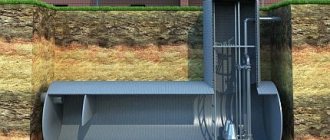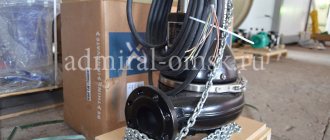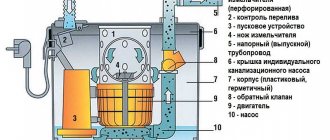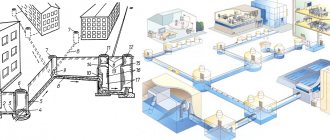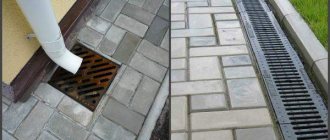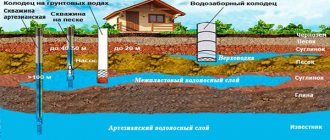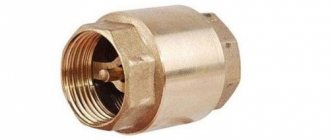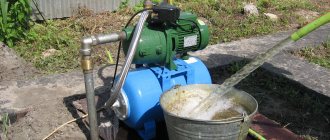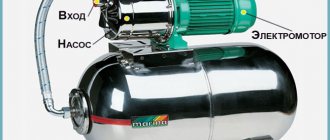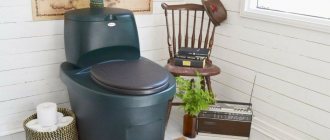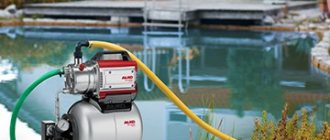When it is not possible to provide the required slope of the sewer pipe, the gravity drainage scheme does not work. In these cases, a sewage pumping station is used to ensure unhindered outflow and recycling of waste.
There are two types of units: mini-stations and full-functional complexes for home maintenance. In this article we will figure out which option is better to give preference to, what characteristics should be taken into account when choosing. In addition, we will describe step-by-step installation technology and operating rules for the sewer station.
Areas of application and purpose of CNS
A sewage pumping station (SPS) is an integral complex of hydraulic equipment, which is designed for pumping storm water, industrial and domestic wastewater when their gravity discharge is impossible.
Large sewage pumping station
Pumping stations can have an additional horizontal cavity to distribute sludge over a larger area, allowing for less sludge removal.
CNS is used mainly in the following cases:
- The geodetic level of the tanks and pipelines from which wastewater is discharged is located below the sewer or cesspool;
- Lack of physical ability to organize straight-line gravity drainage of wastewater or a small slope of the sewer pipe, which threatens its regular clogging;
- The cesspool or central collector is located far from the source of wastewater.
Cottage villages, country houses, as well as industrial facilities located far outside the city and remote from the centralized sewer network are equipped with sewage pumping stations.
Conclusion
As you can see, the KNS station is not that complicated and any home craftsman can install it if desired. The video in this article contains alternative installation options. If you have anything to share or have any questions, write in the comments and I’ll help you in any way I can.
The main unit of any sewerage station is a sewage pump with a grinder.
Classification of sewer stations
The sizes of domestic sewage pumping stations can be very different. They can fit directly behind the toilet and immediately pump wastewater from it in the required direction, or they can take the form of horizontal tanks with a volume of tens of cubic meters dug into the ground.
But it’s not just the size of the CNS that differs. Below are classifications of pumping stations for sewerage according to various parameters.
By installation type:
- Vertical;
- Horizontal;
- With self-priming pumps.
The last type of pumping station involves the forced pumping of wastewater into the station body and its removal from it after treatment.
Mini-KNS for in-house installation
You can even place a mini-sump station in the corner of the bathroom. It produces minimal noise and has an aesthetically pleasing body.
SPS with separately located shut-off valves
When valves and flowmeters are located in a separate dry room, their maintenance becomes safe and comfortable.
SPS with self-priming pumps
The choice of a sewer system with self-priming pumps often depends on the available budget, because the bill runs into hundreds of thousands of rubles. External vertical pump station for home
SPS with exclusively vertical containers are used mainly in private homes.
By type of location relative to the ground:
- Recessed;
- Ground;
- Partially buried.
The water pumping station tank with sensors, sewage pumps and shut-off valves can be located in the ground, and the automatic control system can be located on the surface.
According to the equipment control scheme:
- With manual control . Equipment modules are switched on and off as needed by maintenance personnel, who independently check the fullness of the sewer tank.
- Remote . A tank condition monitoring system is used, the data of which is displayed on a remote control panel.
- Automatic . Control is carried out automatically using sensors and relays located directly in the pumping station housing or next to it.
Manually controlled pumping stations are the cheapest, but require personal participation. They are used mainly in country houses and cottages with a small amount of water consumption.
According to the nature of sewerage:
- For domestic wastewater . Designed for use under standard conditions.
- For industrial purposes . Made from materials with increased resistance to chemically aggressive environments and thermal effects.
- For storm networks . Equipped with additional cleaning systems.
- For sludge wastewater . They are most often used in industrial wastewater treatment plants. Equipped with additional devices for processing sediment.
When choosing a CNS model, it is better to focus not on the classification, but on the recommendations of specialists who will select the optimal system for a particular home.
Sewer ventilation
To prevent CNS from becoming a source of unpleasant odor. it must have ventilation, that is, air circulation. This ensures the removal of harmful gases that will likely arise during the operation of the station.
Pay attention to cooling, as some heat is generated when the pumps operate. In the absence of air exchange, high temperatures can damage the units
Ventilation also needs to be calculated, and it is important to take into account:
- equipment radiation (thermal);
- tank volume;
- humidity level, as it can affect the operation of equipment and electronics.
It is worth considering that the recommended air exchange parameter is considered to be a multiple of five.
Where to install?
If the house has bathrooms below the level of the first floor, that is, the pipeline, it makes sense to install a mini-supply station, and right in the bathroom. Most often this place is the space between the sewer and the toilet outlet. Such equipment mainly has a waste shredder. In order to connect the station, you do not need to use large-diameter sewer pipes. Their outlet has a diameter of 32 to 40 mm.
If there is a greater distance from the house to the collector, then it is advisable to install a standard sewage pumping station, which means it must be installed outside the house. This is a full-fledged station, but on a smaller scale.
Installation of household pump station
Before you begin installation, you need to decide on its location. Most often, there must be a difference between the supply and receiving pipes. But each case should be considered individually, taking into account the specifics of the system and the terrain.
installation of pump station on the bottom of the tank
- First you need to prepare the installation pit. Its dimensions should be larger than that of a sewage pumping station. Moreover, this difference is 10-15 cm. Such a reserve will allow you to connect the pipeline without any particular difficulties.
- The bottom of the hole needs to be compacted. To do this, use a layer of crushed stone, after which a sand cushion is laid.
- A reinforced concrete slab is installed on the sand cushion, and the station is installed on it.
- The pump housing must be attached to the slab.
- Then you should connect the inlet and outlet pipes.
- After all work is completed, the space between the pit and the station is filled with sand.
Start-up and commissioning should only be carried out with the participation of the selling company.
It is important to maintain such a station regularly. In order to do this correctly, you must read the operating instructions
The main points of service are:
- Regular scheduled inspections of the condition of buildings and equipment.
- Annual inspections of equipment, pumps and control units by specialists.
- Removal of sludge deposits. This can be done by pumping them out as needed.
- Removing foreign objects that the safety grill does not allow inside.
Recommended reading: What to do about the smell from the sewer in your apartment?
By following these simple rules, you will be able to use the station for many years.
We have mentioned more than once today about mini-sump stations - these are small-sized installations that are used to pump wastewater from the toilet, including feces and toilet paper. Used in basements and on ground floors.
Such stations have three outputs for connecting different drains:
The installation is a plastic tank in which a submersible pump is located. It is switched on using a hydrodynamic relay when the tank is filled. Mini-KNS includes a cutting mechanism and a receiving filter. The first is responsible for grinding solid and fibrous waste. This allows the use of pipes with a small cross-section. Also, like the older brother of household water pumping stations, it contains a ventilation unit and a locking mechanism that will prevent the overflow of wastewater.
You can install such a station yourself, and you do not need any permits for this. It can work in automatic or forced mode. Most mini-sump pump stations are installed anywhere in the bathroom. There, grinding takes place, only after which the waste enters the sewer system. Drains can rise to a height of up to 6 meters, and the horizontal distance is up to 100 meters.
Equipment selection rules
Next, the criteria will be analyzed, taking into account which it is necessary to select sewage pumping equipment for private use. Analysis of industrial installations is beyond the scope of this review.
The goal when purchasing a pumping station is to purchase equipment that is optimal in terms of power and other characteristics. There is no point in overpaying for systems that will operate at 10-20% of their designed capacity.
When choosing a CNS, the following parameters are taken into account:
- Maximum flow of processed waste.
- Transport distance.
- The difference in geodetic levels between the inlet pipe and the outlet of the pressure hose.
- Degree of pollution, fractional composition and structure of domestic wastewater. There are pumping stations that crush large fractions of inclusions, preventing blockages in pumping equipment.
- Level of wastewater treatment required.
- Equipment dimensions.
There is no single formula for calculating the performance of pumping equipment, therefore the calculation algorithm and the necessary indicators must be specified in the instructions for the purchased pumping station.
A typical project for calculating the performance of pumping equipment includes the following steps:
- Determination of daily water consumption and wastewater volume.
- Construction of an approximate schedule for the flow of sewage wastewater during the day.
- Calculation of minimum and maximum sewer flow.
- Determination of the required productivity of the pumping station, taking into account the contamination of wastewater.
After determining the above parameters, you can begin to select the appropriate equipment.
The price of a pumping station is influenced by the manufacturer’s brand, the maintainability of the product, and the possibility of service. It is especially not recommended to purchase cheap pumps if they are expected to be used daily, and there are no reserve tanks or an additional pump for drainage.
Carrying out calculations
When purchasing a complete SPS, there is no need to buy a very expensive device that will operate at 10% of the declared power. A station is selected based on the following indicators:
- dimensions of the equipment - must be suitable for the room in which installation is planned; for a private house it will be an ordinary household appliance that can be placed on an area of 1 sq. m;
- expected flow of waste liquid - depends on the number of residents and the volume of water consumed during rush hour;
- the distance to which the liquid must be removed;
- height of inlet and outlet pipes;
- equipment performance based on the degree of wastewater pollution.
A household SPS can be connected independently, while large-sized devices are formed from several parts designed for specific operating conditions.
Advantages of pumps for pumping station:
- maintenance requires a minimum of money and effort;
- operate automatically;
- work in any weather conditions.
Quite often, Alta sewage pumping stations replace outdated gravity sewer systems, and they are also used in modern construction conditions. This is due to the huge advantage of sewer stations over “ancient” systems.
Design and principle of operation of the CNS
The design of modern pumping stations should be considered in two main versions:
- sololift;
- sewer station for a house or cottage.
There are no fundamental differences between these devices. But sololifts are a single ready-made piece of equipment that you can buy on the Internet and connect yourself, and sewer stations are formed from separately sold parts for a specific external sewerage project.
Compact mini-stations
Portable pump stations of the Sololift type have a compact appearance and are installed near plumbing equipment. It is installed either in the basement of the house or in the bathroom itself.
Sololift ensures the removal of sewage as it enters the device
The main structural components of the sololift are:
- sealed housing with pipes and holes;
- engine;
- impeller with cutting edge;
- automation.
When water enters the device, the automation is triggered and the engine is turned on. As a result, liquid is pumped from the internal reservoir into the pressure pipe. The impeller additionally crushes large fragments to effectively remove suspended particles and prevent clogging.
When connecting a large number of sewer connections to a mini-sewage station using tees, it is necessary to take into account that the pump performance may not be sufficient to pump the incoming liquid
The sololift body may have 2-5 holes for connecting plumbing fixtures. There is an air valve on top of the device, which allows air to be drawn in from outside when the pump is running. This prevents the water seal in the siphons of home equipment from breaking.
The performance of a portable mini-sump station is standard and is theoretically calculated based on the number of supply pipes. After purchasing the equipment, it is enough to connect the pressure hose and sewer pipes to the solofit body, and then plug it into a power outlet.
KNS for a country house
A pumping station for a private home usually has impressive dimensions and is dug into the ground. It will not be possible to find ready-made design solutions of this type on the Internet, and to determine the approximate cost of the equipment, you need to call store managers or leave a request on the sellers’ websites.
Internal structure of a sewer station
Containers made of fiberglass and plastic are more durable. They do not require any maintenance and will last at least 50 years. The station is a sealed container with pumps inside.
The main elements of CNS for the home are:
- Storage tank made of plastic , fiberglass, concrete or metal with a volume of several cubic meters.
- Fecal pump . In daily operating stations, two pumps are installed: a working one and a reserve one, the task of which is to raise wastewater to a certain level for its further movement through the pipes by gravity.
- A system of gravity water pipelines (supply and pressure discharge), combining internal sewerage, sewage pumping station and subsequent collector. The system is equipped with gate valves and a check valve that allow fluid to flow in only one direction.
- Automation with float switches . It is recommended to install 3-4 floats at the same time, each of which is capable of turning on a pump. They are inexpensive, so there is no need to skimp on them.
Large home pumping stations have an operating principle that is somewhat different from a sololift. The wastewater reservoir is buried in the ground and connected to the internal sewer drain pipe. When the level of sewage wastewater reaches the level set by regulation, the float mechanism closes the network and turns on the pump.
Pumping of water stops only when the float reaches a level much lower than the one that led to its activation. This scheme allows you to turn on pumping equipment less frequently, reducing operating loads.
Additional floats are designed to activate a backup pump. The water level for starting them is set slightly higher than for the main pump.
This allows you to play it safe and turn on backup equipment only in the event of a malfunction of the main one.
Sewage flow meter
Flow meters can record both the flow of liquid in a pressure pipe and in a sewer pipe by analyzing eddy flows.
Wire basket for filtering large debris
The size of the mesh basket cells is selected based on the nature of the expected waste.
Pumping equipment control cabinets
The control panel must be equipped with an alarm that is triggered in the event of a breakdown of the pumping equipment.
Backfill for KNS filter
Sorption filters are relevant only in the case of final discharge of wastewater into water bodies.
Additionally, the KNS can be equipped with the following devices:
- flow meter;
- lattice containers for filtering large debris;
- control and adjustment cabinets;
- ladder for descending into the container;
- vortex flow regulator;
- sorption filters.
The selection of a set of equipment should be carried out only under the supervision of specialists. This will allow you to select components with the most consistent characteristics and productivity.
When to use the pump
A sewerage pumping unit is needed to remove wastewater under pressure. It is used in systems located below the level of the collector. Such situations arise if the building is located in a low-lying area, on a difficult terrain, or when wastewater is transferred through any structures. For example, when a line crosses a highway and horizontal drilling is not possible. We have to make a vertical portal that goes around the road surface from above. The supply of wastewater through a vertical pipeline is possible using special equipment - a mud pump.
The basic design of drainage systems is based on the independent movement of wastewater under the influence of gravity. Gravity networks are cheap and do not require the use of electrical appliances. However, for them to work, it is necessary to ensure a height difference between the starting and ending points. This is not always possible; terrain features, previously laid communications or other obstacles interfere. Installing a sewage pump allows you to organize the supply of wastewater under pressure to a reservoir located at the highest point, from where the liquid can move by gravity.
Installation of a sewage pump is necessary in the following cases:
- location of the house in a lowland, fold of the relief;
- the need to transfer wastewater from the basement or from areas located lower than the street drainage network;
- bypassing highways, exclusion zones of electrical cables or communication wires, gas communications;
- tracing a line on a hillside, the need to raise drains to a higher point;
- drainage from industrial installations or stormwater systems.
In addition to these cases, pumping stations are often used to remove wastewater from apartments where reconstruction, redevelopment or repairs are being carried out. In addition, the pump is often used in premises where the installation of sewerage was carried out with errors and violations of technology. This requires the installation of pressure pipes that can withstand the operating pressure of the pump. The operating principle of the sewerage installation is to increase the pressure in the pipeline. Drains are able to move inside a vertical or inclined pipe in the direction from the lowest point to the highest. To avoid blockages in the pressure pipe, some models are equipped with shredders. They grind large inclusions, organic matter or foreign objects, creating a homogeneous suspension.
Installation instructions for pump station
Installation of household pumping stations is carried out exclusively by qualified workers, due to the high requirements for the accuracy of work and compliance with the sequence of actions.
Failure to comply may result in damage to the tank or associated pipes. Next, we will consider step-by-step instructions for installing the CNS for people who want to do it themselves.
Point No. 1 . The location for installation of the pumping station is being selected. SNiPs require digging a tank at least 20 m from the walls of a residential building. If geodetic levels allow, then it is advisable to choose a higher site so that a lot of groundwater does not accumulate under the station.
KNS should not be installed on the front side of the house, near children's playgrounds and near picnic areas
Point No. 2 . A hole is dug taking into account the diameter of the container and the location for convenient installation work. If the soil is obtained by an excavator, then work must be stopped 20-30 cm above the design level. Next, the soil must be removed manually with a shovel to maintain the integrity of the soil.
When digging a hole for a sewer tank, you do not need to make it huge. A diameter 1.5-2 meters larger than the size of the container itself will be sufficient.
Point number 3 . The type of foundation for installing the water pumping station is selected and installed. To do this, after digging a hole, the soil water content is assessed. If the soil is dry, then you can make formwork and fill it with a 30-centimeter layer of concrete.
And if groundwater constantly seeps into the pit, then only a ready-made reinforced concrete slab with a thickness of at least 30 cm is suitable for the foundation.
The concrete base must be strictly horizontal, so when laying the finished concrete slab you need to take care of this in advance.
KNS containers have a skirt or legs for attaching to the foundation. Anchor bolts are used as fasteners, although when pouring concrete onto the ground, metal rods can also be built into the mixture, onto which the container can then be attached.
You should not skimp on the size of the anchor bolts. Their optimal length is 200 mm, and their diameter is 20 mm. And before laying in liquid concrete, metal rods must be bent with a hook or the letter G
Point No. 4. The water pumping station tank is installed on the foundation, secured and connected to the drain pipe of the internal sewer system of the house. With a vertical type of station and a large amount of groundwater, it is necessary to load the container with concrete. To do this, concrete is poured around the tank 20 cm above the level of the first stiffener of the station.
It should be borne in mind that after pouring concrete it will be impossible to change the tank, so it is necessary to calculate its volume taking into account the expansion of the house and the increase in the number of its residents
Point No. 5 . The station is backfilled with fine soil, the maximum grain size of which is 32 mm. Each layer of earth should be no more than 50 cm. After filling the next belt, it is filled with water for shrinkage and compacted.
This completes the external installation of the pump station. After being fixed in the ground, pumps, sensors, check valves and other auxiliary equipment are installed inside the station.
For safety reasons, it is recommended to close the hatches of sewer tanks with locks, because while playing, children can hide in them and lose consciousness
It would not be superfluous to install an emergency warning system in the house about the critical level of domestic wastewater in the tank, which will warn about malfunctions in the operation of the station.
Typical installation errors
Damage to tank walls, connections or associated pipes can occur if the tank is not installed correctly, tilted or backfilled incorrectly. Such problems threaten manual excavation of the container and considerable financial costs.
Therefore, you should sort out typical mistakes in advance so as not to repeat them when installing your own pump station.
- Incorrect soil filling. Possible mistakes: filling with frozen soil or large stones, lack of layer-by-layer compaction. The consequence may be subsidence of the earth with damage or displacement of the internal pipeline.
- Different type of backfill from different sides . If you poured sand into the pit on one side and earth on the other, then over time the container may become distorted, causing damage to the external pipes or the tank itself.
- Incorrect assessment of the amount of groundwater , which causes severe subsidence of the entire pumping station with rupture of pipes and damage to the reservoir.
- Using wedges to level foundation slabs . The consequence may be a gradual displacement of the tank to the side with rupture of pipes.
Only people with geodetic education and experience in installing similar structures can evaluate the correct installation of the SPS. Therefore, you should not trust the installation of this expensive equipment to non-specialized organizations.
Maintenance of external pump stations
A sewage pumping station is not equipment that you can install and simply be content with its operation. The tank and pumps require regular inspection.
It is strictly prohibited to go down into the tank or carry out cleaning work on your own!
Inhalation of sewer gases can cause sudden loss of consciousness and death if the person is not removed to clean air within a few minutes.
Cleaning the sewage tank
A more profitable option for regularly cleaning a sewer tank is to purchase a gas mask with forced air supply from the surface.
When purchasing a water pumping station, it is advisable to immediately sign a contract for its maintenance.
To access the tank and check the equipment, the stations have a hatch, and deep tanks also have a ladder for descent.
Monthly or quarterly, the service department must:
- check the automation;
- diagnose the operation of the main and backup pumps, check the oil levels in them;
- remove stuck debris from filters;
- remove silt deposits from the bottom.
In case of urgent emergency situations, an independent inspection of the tank is possible, but it must be carried out in the presence of assistants, with a rope harness and wearing a respirator.
